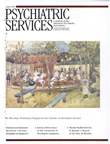Base-rate estimates of criminal behavior by homeless mentally ill persons in New York City
Abstract
OBJECTIVES: The study aimed to estimate the prevalence of homelessness among mentally disordered offenders entering the criminal justice and forensic mental health systems, to compare base rates of arrest for violent and nonviolent criminal charges among homeless and domiciled persons with mental illness, and to examine patterns in the categories of victims chosen by these two groups. METHODS: The authors analyzed data from structured psychiatric interviews and criminal and psychiatric records of 77 homeless defendants and 107 domiciled defendants referred for psychiatric examination by the criminal and supreme courts in Manhattan over a six-month period. RESULTS: Mentally disordered defendants had 40 times the rate of homelessness found in the general population, and 21 times the rate in the population of mentally ill persons in the city. The overall rate of criminal offenses was 35 times higher in the homeless mentally ill population than in the domiciled mentally ill population. The rate of violent crimes was 40 times higher and the rate of nonviolent crimes 27 times higher in the homeless population. Homeless defendants were significantly more likely to have been charged with victimizing strangers. CONCLUSIONS: Homeless mentally ill persons appear to be grossly overrepresented among mentally disordered defendants entering the criminal justice and forensic mental health systems and to have a higher base rate of arrest for both violent and nonviolent crimes than domiciled mentally ill persons.
Access content
To read the fulltext, please use one of the options below to sign in or purchase access.- Personal login
- Institutional Login
- Sign in via OpenAthens
- Register for access
-
Please login/register if you wish to pair your device and check access availability.
Not a subscriber?
PsychiatryOnline subscription options offer access to the DSM-5 library, books, journals, CME, and patient resources. This all-in-one virtual library provides psychiatrists and mental health professionals with key resources for diagnosis, treatment, research, and professional development.
Need more help? PsychiatryOnline Customer Service may be reached by emailing [email protected] or by calling 800-368-5777 (in the U.S.) or 703-907-7322 (outside the U.S.).



